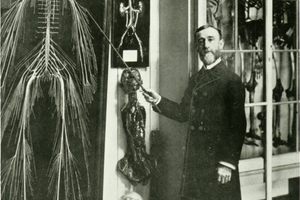About
Charles Willson Peale, an American portraitist, has largely been forgotten by the annals of museum history, but his studio-cum-gallery-cum-natural history museum was one of the first museums in America.
Painters in early America opened small galleries of their work next to their studios. These galleries inticed wealthy patrons to commission portraits by the artist, but they were also for the public to see the visages of famous people before mass print was available. Portraits of George Washington, Thomas Jefferson, Alexander Hamilton and other founding fathers hung on his walls.
Peale was asked to paint mastadon bones that had been found in an excavation out West. Painting the still life in his studio/gallery, the bones fascinated the visitors more than the paintings. By accident, Peale had founded the first natural history museum in America.
He quickly realized that this could be a profitable accident. Driven also by his interest in natural history, Peale began collecting (and acquiring with his own hands) specimens of birds and bones from across North America. Wealthy friends, like Jefferson, also donated pieces to his collection. The museum opened to the public in 1786. While other collections presented bones and birds as oddities of the world, Peale adopted the now familiar Linnean taxonomy of classes, orders, genera and species to organize his museum.
In the 1790s Peale began a public campaign to nationalize his museum - 56 years before the Smithsonian was dedicated. However, the young nation was embroiled with political strife and debt, the Constitution only having been ratified in 1787.
After his death, the museum was shortly cared for by his sons, but some objects were sold off to impresarios like P.T. Barnum and lost to time. The Peale Museum later moved to Maryland and closed in 1997 with the remaining specimens donated to the Maryland Historical Society. Peale's home in Philadelphia is a National Landmark and can be found at 5500 North Twentieth Street.
















